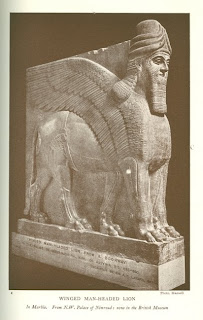

 The first image depicts an overly developed man with the head of an eagle and having four wings, the next two images are animal forms but given human faces/heads. These images from ancient Babylon/Assyria (modern day Iraq), demonstrate a human desire to illustrate their power and traits through a symbolic relationship with the traits of the wild animals which were part of their world. This anthropomorphic attitude can be seen through out the religions of the world which all have roots in the traditions and practices of ancient Babylon.
The first image depicts an overly developed man with the head of an eagle and having four wings, the next two images are animal forms but given human faces/heads. These images from ancient Babylon/Assyria (modern day Iraq), demonstrate a human desire to illustrate their power and traits through a symbolic relationship with the traits of the wild animals which were part of their world. This anthropomorphic attitude can be seen through out the religions of the world which all have roots in the traditions and practices of ancient Babylon.The last image is a called a Karabu. Note what the Catholic Encyclopedia has to say regarding the relationship between the Cherubim (rank of angel) of Judeo/Christian traditions and this Babylonian creation:
"The word cherub (Cherubim is the Hebrew masculine plural) is a word borrowed from the Assyrian kirubu, from karabu, "to be near", hence it means near ones, familiars, personal servants, bodyguards, courtiers. It was commonly used of those heavenly spirits, who closely surrounded the Majesty of God and paid Him intimate service. Hence it came to mean as much as "Angelic Spirit". (The change from K of Karabu, to the K of Kirub is nothing unusual in Assyrian. The word has been brought into connection with the Egyptian Xefer by metathesis from Xeref=Kr-bh.) A similar metathesis and play upon sound undoubtedly exists between Kerub and Rakab, "to ride", and Merkeba, "chariot". The late Jewish explanation by analogy between Keerub and Rekub, "a youth", seems worthless. The word ought to be pronounced in English qerub and querubim, and not with a soft ch."
Here we can trace the origin of an angelic form back to an idea of Babylonian anthropomorphic blending.



No comments:
Post a Comment